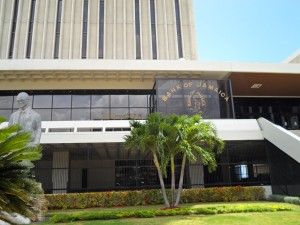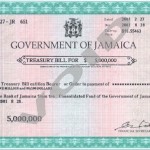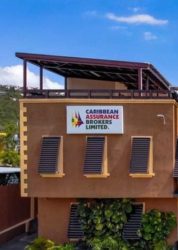 PAYE collections, outperformed forecast for September, by $620 million and $677 million, for the six months to September, this year, but that was inadequate to cover the $2.5 billion drop in corporate taxes, in the latest month, for government of Jamaica revenues.
PAYE collections, outperformed forecast for September, by $620 million and $677 million, for the six months to September, this year, but that was inadequate to cover the $2.5 billion drop in corporate taxes, in the latest month, for government of Jamaica revenues.
At the end of August, corporations paid over $6.63 billion versus a projection for $8.8 billion, resulting in a shortfall of $2.18 billion, by the end of September, what should have been collections of $15.3 billion turned up to be only $10.65 billion, $4.7 billion short, resulting in a $2.5 billion shortfall, in the latest month alone. The underperformance for company tax collection, was the main reason why the revenue forecast of $156.5 billion for the six months period, suffered an increased shortage of $1.4 billion in tax revenues, bringing the year to date shortfall, to $7.33 billion. Overall revenue shortage, amounted to $7.13 billion, as grants fell short by $337 million in September, but non tax revenues outperformed forecast, by $400 million for the month.
Expenditure| Payment for expenses is well below target, as capital expenditure almost crawled to a halt in September, with only $590 million spent, raising the underspending for the year to date to $7.8 billion, up from $5.38 billion at the end of August. Programmes saw savings in payments of nearly $900 million, in the month, and wages and salaries was $350 million more, in the month, than planned, but there is still a reduction year to date, in this area.
At the end of September, the fiscal deficit of $18.95 billion was ahead of target by $6.3 billion, as the capital programmes have once more taken the bulk of the hit, as revenues fall short of target.
PAYE gains can’t cover corporate shortfall
Low forex demand forced BOJ’s intervention
IC Insider can now confirm that the country’s central bank (Bank of Jamaica) has been intervening in the market to purchase excess funds and thus prevent too much appreciation for the Jamaican dollar at a time when the rate of inflation has been rising and could erode the gains made against the US dollar, in 2014.
Authorized dealers purchased the equivalent of US$32,649,087 versus US$32,884,034, on Wednesday and sold the equivalent of US$28,021,523 compared with US$32,831,045 on Wednesday.
 In US dollar trading, dealers bought US$25,714,484 compared to US$30,229,144 on Wednesday. The buying rate for the US dollar lost 3 cents to $112.32 and US$24,894,405 was sold versus US$31,632,195 on Wednesday, the selling rate rose 3 cent to $112.76. The Canadian dollar buying rate, rose $2.38 to $100.66 with dealers buying C$3,327,907 and selling C$1,986,255, at an average selling rate that climbed $1.37, to $101.98. The rate for buying the British Pound moved down 85 cents to $178.10, for the purchase of £943,417, while £400,984 was sold, at $180.46, a fall of $1.02. Other currencies bought, amounted to the equivalent of US$2,456,217, while the equivalent of US$689,010, was sold.
In US dollar trading, dealers bought US$25,714,484 compared to US$30,229,144 on Wednesday. The buying rate for the US dollar lost 3 cents to $112.32 and US$24,894,405 was sold versus US$31,632,195 on Wednesday, the selling rate rose 3 cent to $112.76. The Canadian dollar buying rate, rose $2.38 to $100.66 with dealers buying C$3,327,907 and selling C$1,986,255, at an average selling rate that climbed $1.37, to $101.98. The rate for buying the British Pound moved down 85 cents to $178.10, for the purchase of £943,417, while £400,984 was sold, at $180.46, a fall of $1.02. Other currencies bought, amounted to the equivalent of US$2,456,217, while the equivalent of US$689,010, was sold.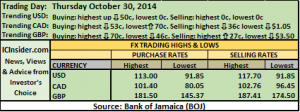 Highs & Lows| The highest buying rate for the US dollar, fell 50 cents to $113, the lowest buying, the highest selling and the lowest selling rates were unchanged at $91.85, $117.70 and $91.85 respectively. The highest buying rate for the Canadian dollar fell 53 cents to $101.40, the lowest buying rate rose 70 cents to $80.05, the highest selling rate fell 36 cents to $102.76. The lowest selling rate declined $1.05 to $96.45. The highest buying rate for the British Pound, dipped 70 cents to $181.50. The lowest buying rate eased 46 cents to $145.37, the highest selling rate rose 27 cents to $187.41 and the lowest selling rate dropped $3.50 to $174.50.
Highs & Lows| The highest buying rate for the US dollar, fell 50 cents to $113, the lowest buying, the highest selling and the lowest selling rates were unchanged at $91.85, $117.70 and $91.85 respectively. The highest buying rate for the Canadian dollar fell 53 cents to $101.40, the lowest buying rate rose 70 cents to $80.05, the highest selling rate fell 36 cents to $102.76. The lowest selling rate declined $1.05 to $96.45. The highest buying rate for the British Pound, dipped 70 cents to $181.50. The lowest buying rate eased 46 cents to $145.37, the highest selling rate rose 27 cents to $187.41 and the lowest selling rate dropped $3.50 to $174.50.
Berger surges to the top
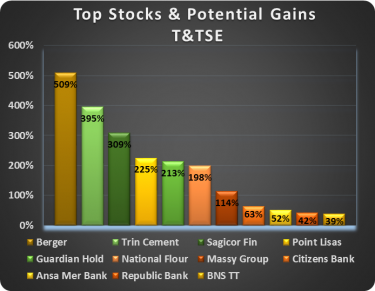 Berger Paints surged to the top of the list of stocks on the Trinidad & Tobago Stock Exchange that should return the highest gains to investors, in the months ahead, with the potential to reach 500 percent.
Berger Paints surged to the top of the list of stocks on the Trinidad & Tobago Stock Exchange that should return the highest gains to investors, in the months ahead, with the potential to reach 500 percent.
Next in line is Trinidad Cement with 300 percent. Scotiabank has fallen to $58 from a high of $73.12 earlier this year. At the close of trading for the week, Scotiabank’s price seems set to decline further, with selling pressure still overwhelming buying interest, at the current price level. The decline so far has put the stock back in the list of top buys, with potential gain of 40 percent at the last traded price. The bank reported poor results in the first half of the fiscal year, but showed strong gains in the July quarter including good pick up in loans. This suggest that 2015 earnings should move up attractively, subject to continued growth in the loan portfolio. Importantly the PE has fallen in line with Republic Bank at around 16 times earnings and only slightly above the rest. Berger has surged based on the latest results, putting profit for the six months to September at $1.122 million, a big improvement over than the $240,000 earned in the 2013 period and almost ensuring that the full year’s earnings of $2.93 million to March this year, will be bettered by a good degree. 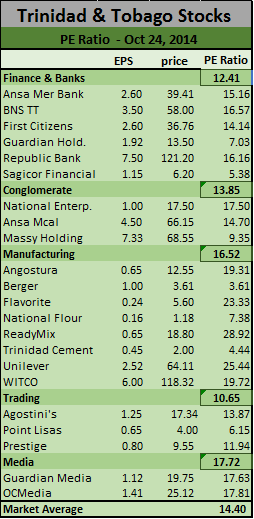 Berger’s profit improvement is flowing from reduced cost rather than sales growth. Sales fell slightly to $29.8 million for the half year, compared to $30.1 million in the 2013 period. IC Insider is forecasting $1.10 per share, around $6 million after tax for the current year.
Berger’s profit improvement is flowing from reduced cost rather than sales growth. Sales fell slightly to $29.8 million for the half year, compared to $30.1 million in the 2013 period. IC Insider is forecasting $1.10 per share, around $6 million after tax for the current year.
Rounding out the top list of the stocks that virtually select themselves are, Sagicor Financial, Point Lisas, Guardian Holdings, National Flour Mills, Massy Holdings, First Citizens Bank, Ansa Merchant Bank, Republic Bank and Scotiabank.
The 2014 financial year for a number of the companies have ended in September, with more results to be released soon. Investors’ minds will start to focus on 2015 when the results for some of the companies will show improvement over 2014, making the stocks cheaper now than they are likely to be a few months from now when the results for 2015 starts to flow.
Trinidad Cement released their nine months results to September which point to earnings from continuing operations being 13 cents for the quarter and annualised at 52 cents per share. The agreement to supply Venezuela with 240,000 tonnes of clinker will help boost the group’s profit, while the contract is being satisfied. While debt is a negative, the present cash flow if continued, will see them out of danger within 3-4 years.
Overall the TTSE market average PE is at 14.4 with 12 stocks above this levels and 10 stocks below.
Treasury-bill rates fall again
The Treasury bill for the period Friday, October 24 to mature on Friday, January 23 next year, attracted an average yield of 7.336 percent, down from 7.46952 percent, at the September auction. At the August auction the average rate out turn was 7.46767 percent. The yield for July was an average of 7.63643 percent, for the June issue 7.65893 percent and 8.2 percent in May, for the Treasury bill of same duration.
The offer of 182 days duration, maturing on April 24 next year, generates an average interest rate yield of 7.73187 percent, a decline from 7.99887 percent, at the September auction, 8.11578 percent, in August, 8.21982 percent at the July’s auction and 8.36502 percent for the June issue, of the same duration. At the May Treasury bill auction, the rate came out at 8.932 percent.
BNS & NCB in grand US$ sell off on Friday
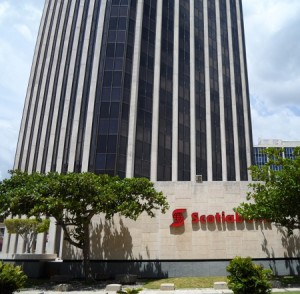 Authorized Dealers sold much more foreign currency that they bought on Friday. Bank of Nova Scotia (BNS) and National Commercial Bank (NCB) were big net sellers of the US dollar, the second consecutive day of a big net sell off by dealers. BNS was the largest net seller, with US$4.58 million bought to US$15.26 million sold, followed by NCB buying US$4.13 million and selling US$12.6 million. On Thursday BNS bought US$7.33 million and sold US$14.23 million while National Commercial Bank, was buying US$2.67 million and selling US$5.54 million.
Authorized Dealers sold much more foreign currency that they bought on Friday. Bank of Nova Scotia (BNS) and National Commercial Bank (NCB) were big net sellers of the US dollar, the second consecutive day of a big net sell off by dealers. BNS was the largest net seller, with US$4.58 million bought to US$15.26 million sold, followed by NCB buying US$4.13 million and selling US$12.6 million. On Thursday BNS bought US$7.33 million and sold US$14.23 million while National Commercial Bank, was buying US$2.67 million and selling US$5.54 million.
The Jamaican dollar slipped slightly against the US dollar, but appreciated against the Pound and the Canadian dollar, in Friday’s forex trading. Authorized dealers purchased the equivalent of US$49,065,272 versus US$27,673,332 on Thursday. The equivalent of US$60,366,852 was sold, compared with US$42,183,198 on Thursday.
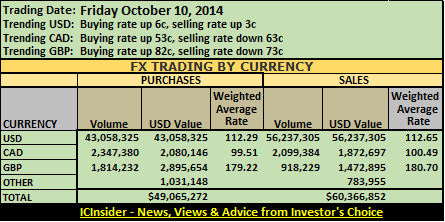 In US dollar trading, dealers bought US$43,058,325 compared to US$25,657,012 on Thursday. The buying rate for the US dollar was up 6 cents to $112.29 and US$56,237,305 was sold versus US$40,190,794 on Thursday, the selling rate rose 3 cents to $112.65. The Canadian dollar buying rate, climbed 53 cents to $99.51 with dealers buying C$2,347,380 and selling C$2,099,384 at an average selling rate that declined 63 cents, to $100.49. The rate for buying the British Pound is up by 82 cents to $179.22, for the purchase of £1,814,232, while £918,229 was sold, at $180.70, down 73 cents. Other currencies bought, amounted to the equivalent of US$1,031,148, while selling was for the equivalent of US$783,955.
In US dollar trading, dealers bought US$43,058,325 compared to US$25,657,012 on Thursday. The buying rate for the US dollar was up 6 cents to $112.29 and US$56,237,305 was sold versus US$40,190,794 on Thursday, the selling rate rose 3 cents to $112.65. The Canadian dollar buying rate, climbed 53 cents to $99.51 with dealers buying C$2,347,380 and selling C$2,099,384 at an average selling rate that declined 63 cents, to $100.49. The rate for buying the British Pound is up by 82 cents to $179.22, for the purchase of £1,814,232, while £918,229 was sold, at $180.70, down 73 cents. Other currencies bought, amounted to the equivalent of US$1,031,148, while selling was for the equivalent of US$783,955.
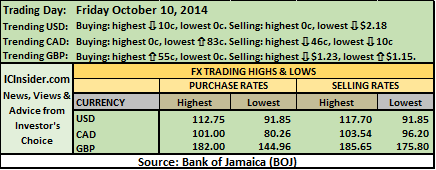 Highs & Lows| The highest buying rate for the US dollar, closed 10 cents lower, at $112.75, the lowest buying and the highest selling rates, were unchanged at $91.85 and $117.70 respectively, the lowest selling rate dropped $2.18 to $91.85. The highest buying rate for the Canadian dollar remained at $101, the lowest buying rate rose 83 cents to $80.26, the highest selling rate fell 46 cents to $103.54. The lowest selling rate closed down 10 cents to $96.20. The highest buying rate for the British Pound, increased by 55 cents to $182, the lowest buying rate was unchanged at $144.96. The highest selling rate, dropped $1.23 to $185.65 and the lowest selling rate rose $1.15 to $175.80.
Highs & Lows| The highest buying rate for the US dollar, closed 10 cents lower, at $112.75, the lowest buying and the highest selling rates, were unchanged at $91.85 and $117.70 respectively, the lowest selling rate dropped $2.18 to $91.85. The highest buying rate for the Canadian dollar remained at $101, the lowest buying rate rose 83 cents to $80.26, the highest selling rate fell 46 cents to $103.54. The lowest selling rate closed down 10 cents to $96.20. The highest buying rate for the British Pound, increased by 55 cents to $182, the lowest buying rate was unchanged at $144.96. The highest selling rate, dropped $1.23 to $185.65 and the lowest selling rate rose $1.15 to $175.80.
Jamaica’s remittance inflows grow
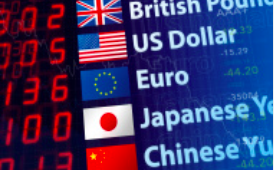 Remittance inflows into Jamaica, this year, continue to grow, with an increase of US$50 million or 5.6 percent in net remittances for the six months to June, over the same period in 2013, to reach US$949 million, according to information released by the country’s central bank.
Remittance inflows into Jamaica, this year, continue to grow, with an increase of US$50 million or 5.6 percent in net remittances for the six months to June, over the same period in 2013, to reach US$949 million, according to information released by the country’s central bank.
“Total remittance inflows were US$1.06 billion, an increase of US$35 million while outflows declined compared with the 2013 period,” the Bank of Jamaica report states. Net remittances for June 2014, were US$154 million, an increase of US$8 million or 5.4 percent over the corresponding period of 2013, resulting from an increase in gross remittance inflows and a contraction in outflows. Gross remittance inflows for the month were US$168 million, an increase of US$2.3 million or just 1.4 percent relative to the corresponding month of 2013.
For June, total Remittance Outflows amounted to $15 million a reduction from the $20 million in June 2013 and for the six months, $106 million and $121 million in 2013.
NIR up in September
 Bank of Jamaica paid back US$30 million to the International Monetary Fund (IMF) during September, but the Net International Reserves (NIR) climbed from US$2.12 billion at the end of August to US$2.2 billion at the end of September, an increase of US$79 million.
Bank of Jamaica paid back US$30 million to the International Monetary Fund (IMF) during September, but the Net International Reserves (NIR) climbed from US$2.12 billion at the end of August to US$2.2 billion at the end of September, an increase of US$79 million.
Gross reserves amounts to $2.72 billion compared with $2.67 billion at the end of August.Estimated Official Gross Reserves represent 27.17 weeks of Goods Imports at the end of September, up from 26.68 weeks, in August and 19.52 weeks of Goods and Services Imports, an increase over the 19.17 weeks in August.
The reserves place the central bank in a good position to intervene in the foreign exchange market during the rest of the year, if they so desire. Importantly, it gives them the physiological advantage to keep speculators guessing as to their next move, now that the rate of the Jamaican dollar has been gaining, against the US dollar, since they had a major intervention, in the market on July 10.
Interestingly, the months of high demand and low supply commencing September, should end by Mid December has so far seen no serious dip in supply and no large demands, allowing the local dollar to appreciate. There are some indications that financial institutions who went long in their holdings of foreign exchange, have been offloading, with the absence of any serious overhang of demand that cannot be satisfied.
It does appear that the central bank will be adding to its holdings of foreign currency, as investors reduce their holdings, with the winter months not far away, a period when supply is usually higher than demand.
J$ revalues against 3 main currencies
 In today’s world people are so busy, they don’t have time to smell and admire the beauty of the roses, around them. Busy as we are, things are happening under our very eyes and feet, and many don’t even know it. Generally, we are headline people, the details we leave for another time.
In today’s world people are so busy, they don’t have time to smell and admire the beauty of the roses, around them. Busy as we are, things are happening under our very eyes and feet, and many don’t even know it. Generally, we are headline people, the details we leave for another time.
Jamaicans have been so caught up with concern of the effect of the sliding dollar Jamaican dollar against the US dollar and the impact on their lives, they have not been paying attention to the details of what is taking place in the overall currency market.
Internationally, there have been lots of movements in major world currencies this year. The Pound lost 4 percent, the Canadian 5 percent and the Japanese yen 4 percent against the US dollar so far this year. The local currency has had moderate revaluation against the US dollar since hitting a low of $112.87 in July and is now at $112.64 as of Friday. But the revaluation against the Canadian since its low of 107.55 on July 9 up to Friday when it closed at $100.80 to the Canadian is much larger at 6 percent and the revaluation against the British pound is even more, with the Pound declining from $193.50 on July 16 to $180.17 on Friday Oct 3, a gain of nearly 7 percent for the Jamaican dollar. Based on the flows of these two currencies, where inflows are always more than sales the revaluation against them could well be greater than these numbers show, if normal market forces were to prevail.
 At the end 2013 the US dollar was selling for $106.38, the Canadian for $99.22 and the Pound at $175.84, to the Jamaican dollar. The end result is that the Jamaican dollar, has hardly lost value against the Canadian so far and the Pound is down around 2.5 percent for the year to date, but Jamaican dollar has devalued 6 percent versus the US dollar, this year so far.
At the end 2013 the US dollar was selling for $106.38, the Canadian for $99.22 and the Pound at $175.84, to the Jamaican dollar. The end result is that the Jamaican dollar, has hardly lost value against the Canadian so far and the Pound is down around 2.5 percent for the year to date, but Jamaican dollar has devalued 6 percent versus the US dollar, this year so far.
Factors that could play out going forward. The tight fiscal discipline that the Jamaican government has to adhere to, is squeezing excesses out of the system and reducing demand for foreign exchange. The Bank of Jamaica’s large intervention in July, seems to have removed the overhang of demand for US dollar from the system. The expected high demand, low inflow period from September to mid-December is not reflecting the usual pattern of past years, allowing some revaluation to take place. The stability is encouraging portfolio shifts out of foreign exchange holdings, back into Jamaican dollar, as investors see a long period of stability to at least late next year. The rise in US dollar, is one reason why the devaluation of the Jamaican dollar versus the Pound and Canadian dollar, have been very moderate so far, this year. The US dollar rise is reducing the cost of oil, the price has fallen a bit this year from a peak of US$105, and is now at $89, having spent March to July over $95, the forecast is for lower prices as the US dollar gets stronger, with economic activity in the US picking up steam. Lower oil prices, mean less costly import of the commodity for Jamaica. The final scenario is how much change will Bank of Jamaica allow in the local currency?
GOJ tax revenue continues to lag
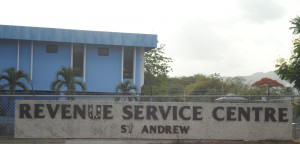 Government of Jamaica’s tax revenues for August, fell below target, resulting in a shortfall of $2.56 billion at the end of July, climbing to $5.9 billion at the end of August. Payments were also less than planned, with underspending of $7.69 billion at the end of July, climbing to $10.26 billion to August.
Government of Jamaica’s tax revenues for August, fell below target, resulting in a shortfall of $2.56 billion at the end of July, climbing to $5.9 billion at the end of August. Payments were also less than planned, with underspending of $7.69 billion at the end of July, climbing to $10.26 billion to August.
The fiscal deficit came in at $27.2 billion versus a budgeted $31.6 billion, $4.4 billion over projection. At the end of July, the deficit was $18 billion or $5 billion ahead of plan.
Revenue shortfall was experienced in Company tax collection, $2.2 billion lower than the $8.8 billion forecast and is slightly worse than the $1.9 billion shortage to July. Tax on interest which was ahead at $1.6 billion is now up by $1.9 billion. Local GCT fell short, $3.5 billion to August, worse than the $1.6 billion shortfall to July. GCT and SCT on imports fell short 900 million at the end of July and $1.2 at the end of August with SCT on target to August, up a bit from the $445 million shortfall at the end of July.
Spending on capital, budgeted at $14.8 billion has had only $9.5 billion spent so far in 2014.
Jamaica’s business confidence drops
 Perception of present and future conditions is down in the business sector, according to data of a survey, released by Bank of Jamaica. The survey which was done in August showed a deterioration compared to June.
Perception of present and future conditions is down in the business sector, according to data of a survey, released by Bank of Jamaica. The survey which was done in August showed a deterioration compared to June.
In the recent survey, there was a marked moderation in both the perception of present and future business conditions among respondents relative to the previous survey. The indices showed current business conditions at 110.2 versus June’s 121.1 and 102.5 in May. The perception of future business conditions as measured by the index declined to 119.4, from 129.9 in June. The level is still ahead of the May 2014 outturn, of 117.9.
The perceptions of present and future business conditions, continue to show a general upward trend since the low of 47.5 percent in April 2013 survey, for current business condition and 93.4 for future business conditions. The indices peaked at 157.9 in December 2011 for current business conditions and 148.8 in March 2013 for future business conditions.
